Home grown tomatoes
Trialing an assortment of different tomato varieties is the best way to work out which are best for you and your garden’s soil and climate. Garden centres offer a good range of young seedlings and grafted plants. An even wide choice of varieties is available as seeds.
Heirloom tomatoes
Tomatoes that have been passed down through generations for fifty years or more (sometimes hundreds), include some familiar favourites and others more recently rediscovered with enthusiasm. Look to heirloom tomatoes for a great choice of colours and shapes.
Many heirlooms lost out to higher yielding hybrids over the decades, but as many gardeners are discovering, that higher ratio of foliage to fruit can mean a tastier tomato, because the sugars and acids that make up the flavour are made in the leaves.
Heirloom seeds come from open-pollinated (non-hybrid) plants, which means they have adapted to local growing conditions over the decades. As a result, excellent disease resistance is found among heritage varieties.
Reliable Money Maker has been supplying gardeners with tasty medium sized-fruit for well over a century. It is disease resistant and high yielding. Heirloom Brandywine Pink originates from the Amish communities in 1885. Its large ‘beefsteak’ fruits are pinky-red with green shoulders.
Fill the freezer
Quick maturing, high yielding tomato varieties provide generous surpluses for sauces and stashing away in the freezer for winter meals. Pear shaped Roma tomatoes are the classic Italian style favourites. Roma Acid Free is a prolific performer with deep red fruit, rich in flavour. Russian Red is easy to grow in a wide range of climates. A compact semi-dwarf variety that can be grown without staking, this early bearer produces huge crops of round medium sized fruits. It’s another reliable old-timer with great disease resistance.
Beyond red
Tomatoes come in an exciting colour range; yellow, orange, pink, purple - even black. There are those with stripes and patterns. Skin colour can be an indicator of different health properties. Unique Tomato Yoom is a premium quality black-purple tomato described as not too sweet and not too sour. Maximum sunshine produces the darkest, near black fruit.
Super-sized
The huge, juicy sandwich tomato we know and love as the ‘beefsteak’ type is the holy grail of home grown tomatoes. These classic giants get bigger and bigger. Award winning hybrid, Big Beef produces heavy yields of large, juicy fruit weighing up to 350 grams with the old-fashioned beefsteak flavour. These broad shouldered beauties promise good rich flavour too, and with a sturdy support system plants will reward with high yields.
Little sweeties
Super easy to grow, quick to crop and terrifically tasty, cocktail and cherry tomatoes are great for beginner gardeners. They come in all sorts of colours and growth forms and if you want to grow tomatoes in containers these lunch-box sized treats are just perfect. Dwarf patio tomatoes like Patio Prize, Yates Patio Mini and Yates Small Fry hybrid are particularly good in pots. These bushy plants are less than a metre tall and can be grown without staking.
Taller growing Sweet 100 is the widely popular and prolific cherry tomato, famous for producing 100 or more little fruit on each plant. Campari is a ‘cocktail’ variety, slightly bigger than a cherry tomato. It is renowned for its superior disease resistance, sweetness and flavour.
Growing tomatoes from seed
When its warm enough, tomato seeds germinate easily in garden soil, but by this time we are half way through the season. So, to get a head start and a good long growing season it's best to start in spring, sowing seed into clean trays filled with good quality seed raising mix (which is free of weeds and disease spores). This way seedlings can be protected from the cold until it’s warm enough to plant outdoors.
One packet of seeds produces a lot of plants. Many gardeners swap seedlings with friends to get a better mix of varieties. Ideal for those keen to experiment, Yates have a special lucky dip of ‘Heirloom Favourites’ in their packet seed range. Choose a suitable container. This could be a conventional seed tray, a recycled garden centre punnet or other recycled container. Sowing into a punnet with individual ‘cells’ makes it easier to transplant the seedlings without disturbing the young roots.
A deeper root space means seedlings can stay in their pots for longer. However, a shallower seed bed is warmer, and the warmer they are, the quicker tomato seeds will shoot. A tray depth of 4 to 5cm is enough to get young seedlings started and they can be moved on to a bigger pot once they are growing strongly. Your seed tray must be deep enough to allow some space on top for water to soak in. Drainage holes are essential; seeds and young seedlings will rot in cold wet soil.
After sowing, place the tray in a warm sheltered place and keep the mix just moist. Don’t forget to label each tray if you are sowing different varieties. A week or two after germination, when seedlings are about 5cm tall, thin them out to give them more space (about 5cm apart) or transplant them into individual pots, taking care not to damage the roots. A plant label or ice cream stick makes a useful tool to gently scoop out the young plant as you hold the leaves in your fingers.
When the danger of frost has passed and seedlings have at least four strong leaves, it’s time to plant them out into the garden or into large pots and tubs to grow on to maturity.
How to grow tomatoes
Warmth and sunshine
Tomatoes need warm weather. It’s risky to plant outdoors before the last expected frost, but make the most of summer by getting plants in well before Christmas. Choose a warm sheltered spot with as much sun as possible.
Soil and planting
Plant tomatoes in a sunny loaction with well-drained, compost-rich soil. If planting where tomatoes grew last year, dig out the soil and replace it with clean compost or soil to reduce the risk of disease. Place stakes at planting time to avoid damaging the roots later. Water new plants an hour or so before planting. Water again after planting and finish off with organic mulch to conserve moisture.
Watering
Tomatoes need a consistent supply of moisture and plenty of it. It is important to water deeply with a thorough soaking once or twice a week, rather than daily surface watering. This will encourage the roots to grow deeper into the soil where they are less likely to dry out. Tomatoes growing in pots, however, need watering every day. To avoid disease, water the roots, not the foliage.
Feeding
However you choose to feed your tomatoes, high yielding plants need lots of feeding. An easy way to be sure of the best balance of nutrients, is to use a fertiliser designed for tomatoes with optimal potassium for fruiting. Sheep pellets applied at planting time and liquid fish fertilisers applied regularly during fruit formation also give good results. Seaweed enhances nutrient uptake and encourages strong healthy root growth.
Staking and training
Compact bush tomatoes which quickly grow to a finished height then produce a bumper crop all at once are known as determinate varieties. These early bearers suit cooler climates and can be grown without staking or pruning.
Most tomato varieties are indeterminate, which means they will keep growing, flowering and fruiting until stopped by frost. These taller types include the big beefsteaks and they need support structures for best results. Removing the little side shoots (called laterals) which appear between each leaf and the main stem helps to keep the plant growing in the right direction and prevents overcrowding. Do this every few days when the weather is fine, lightly tying new growth to stakes with flexible ties. Towards the end of the season, removing the growing tips diverts energy into the ripening fruit.
Keeping Tomatoes healthy
- Start with a selection of disease resistant varieties.
- Don’t plant tomatoes in the same soil in consecutive years.
- Remove tomato laterals only on dry days and use clean hands.
- Use sharp, clean secateurs to remove lower leaves if they become diseased.
- Apply copper or dab with Yates Tomato Dust when removing laterals or cutting off leaves.
- Avoid overhead watering. Apply water at ground level and water deeply to encourage deep roots.
- Allow space for air movement around plants.
- Mulch to cut down on watering and slow weed growth. Weeds encourage disease!
- Choose early ripening varieties to avoid the more humid conditions of late summer.
- Plant flowers to attract predatory insects.
- Buy fresh seed or seedlings from a reputable supplier. Seed saved from an infected crop may carry over disease to the next crop.
- Cover with fine insect mesh to protect against psyllid.

15-Sep-2022

Tomatoes come in a variety of sizes, shapes and colours
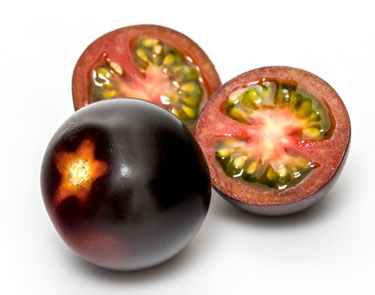
Tomato Yoom

Tomato Big Beef

Cocktail tomato Sweet Million
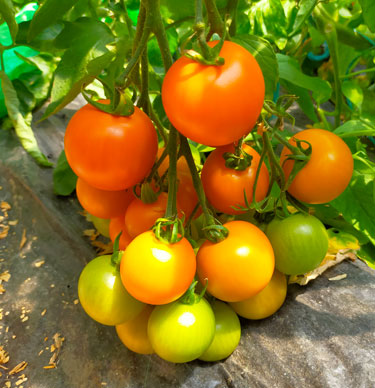
Orange heritage tomato Moonbeam is high in tetra-cis-lycopene, a cancer and heart disease fighting antioxidant.
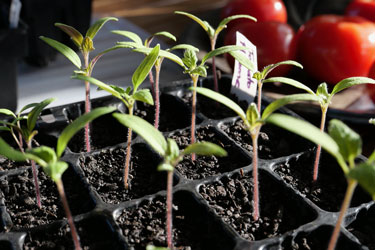
Tomato seedlings grown from seed
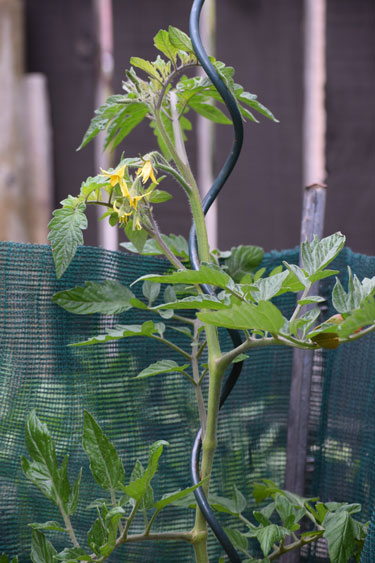
Spiral stakes make supporting and training tomato plants easy.
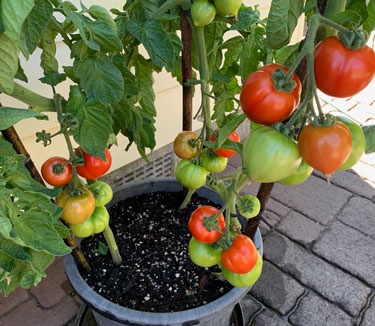
Tomatoes can be successfully grown in pots with attention to feeding and watering
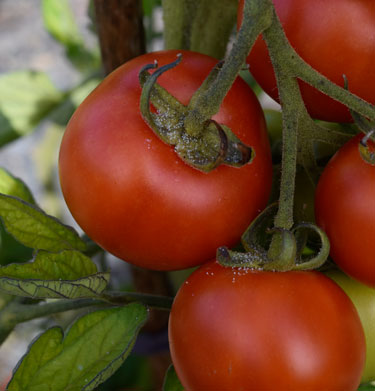
Psyllid 'sugars' on fruit

